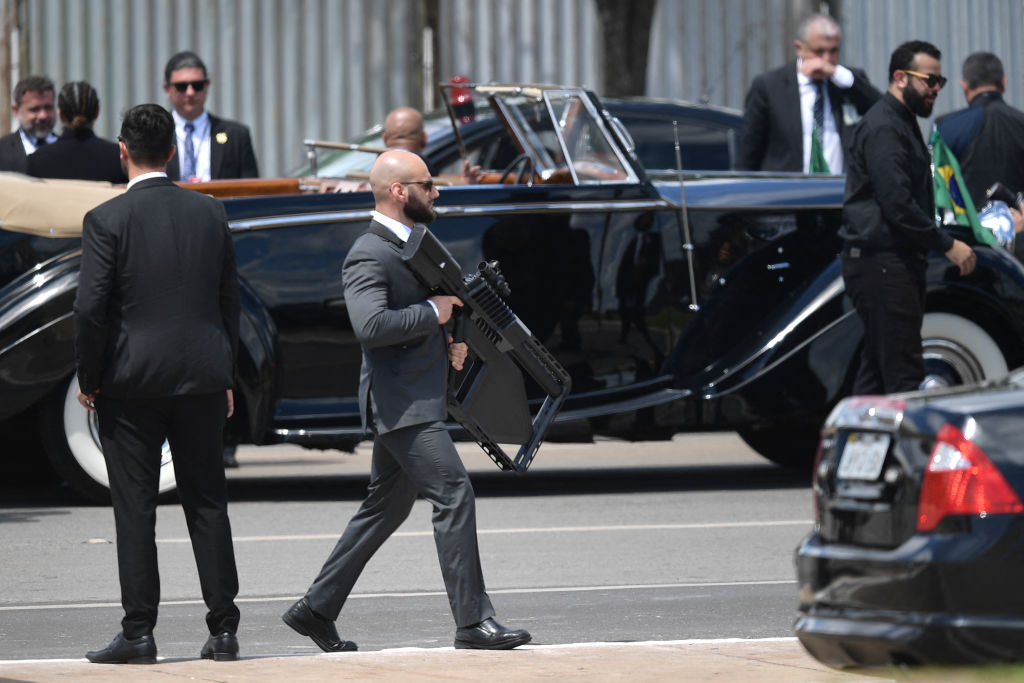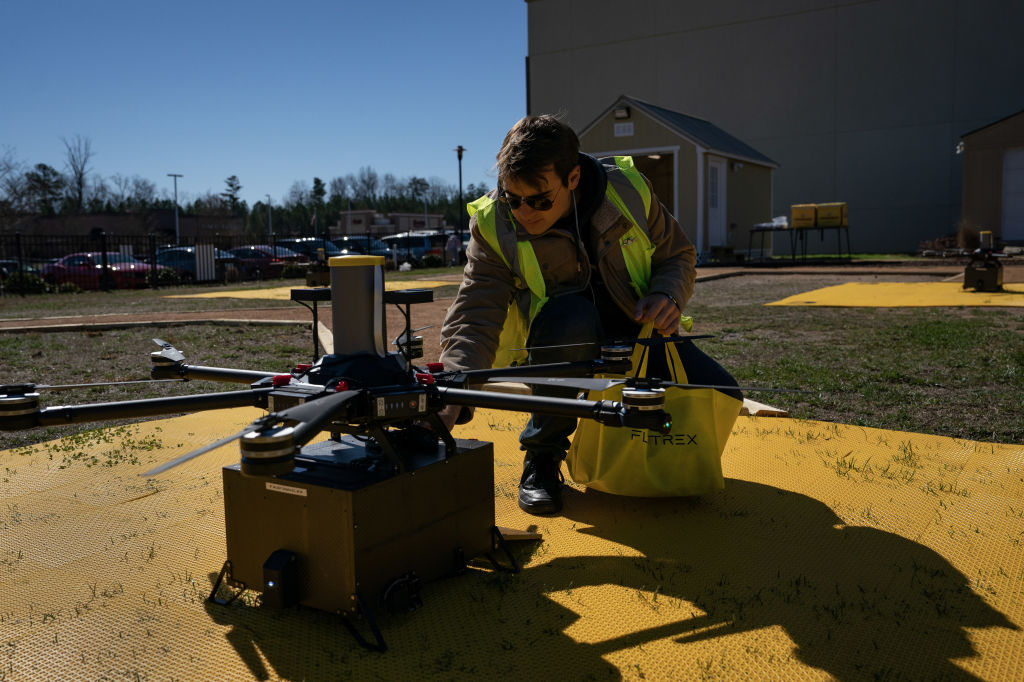
On the top floor of a squat Singapore industrial estate, wedged between a railway depot and water reclamation plant, is a young security firm that’s shooting for the stars. Well, shooting for anything beneath the stars that shouldn’t be there, technically speaking. TRD is one of the world’s leading purveyors of anti-drone technology—a burgeoning industry worth some $1.1 billion last year and projected to grow to $7.4 billion by 2032.
“Anti-drone is the hot topic right now,” says TRD CEO Sam Ong, a former officer in the Singapore Armour Corps, where he specialized in tank technology. “Unmanned warfare is taking center stage, especially in the Ukraine war.”
Vladimir Putin’s invasion of Ukraine has raised the profile of drone warfare, with some 600 unmanned aerial vehicles (UAVs) from both sides estimated to take flight above the beleaguered country every day. The potential for UAVs to tip the geopolitical needle was spotlighted by the downing of a U.S. military drone by a Russian fighter last week—the full consequences of which have not yet become apparent.
But the threat from drones is far broader. Commercial drones are typically sold with preset “geofencing” that prevent their flight near sensitive locations—however, these guardrails are easily hacked. In recent years, drones have smuggled drugs across borders and into prisons; disrupted countless sporting events; and attempted to assassinate Venezuelan President Nicolás Maduro. In June, a kamikaze drone struck Russia’s Novoshakhtinsk oil refinery, sparking a large blaze. UAVs have proven a regular menace at airports. (Closing Dubai International Airport for a drone incursion, for example, costs $100,000 every minute.) Drone threat intelligence firm DroneSec recorded 2,554 major illicit drone incidents in 2022—a 60% year-over-year rise.
Ultimately, today’s proliferation of cheap UAVs means anything worth guarding by a regular fence—whether power plant, university, prison, or private residence—also requires protection from the skies above. Actually doing so, though, is not so easy. When North Korea sent five drones over its southern border in December, South Korean Airforce jets and attack helicopters chased them fruitlessly for five hours, firing over 100 rounds, but they all returned home unharmed. One of the South Korean jets crashed, however, prompting President Yoon Suk-yeol to bemoan his military’s readiness was “greatly lacking.”
Enter firms like TRD—the initials stand for “tiny red dot,” a self-deprecating nickname for Singapore—which Ong founded in 2011. It deploys either fixed, vehicle-mounted or hand-held Orion “drone-slayer” devices that interfere with drones’ internal navigation and force them to either drop or veer off-course. Business is booming; TRD saw revenue of $30 million last year with Ong aiming for $150 million by 2026, with offices and representatives across Southeast Asia, the Gulf, Europe and the Americas.
But technology is just one aspect of this contest. Regulations covering counter-drone technology vary greatly between legal jurisdictions. Police in the Netherlands are even training eagles to swoop on aberrant drones. Currently, the U.S. has few restrictions on the flight of drones over private property, while the deployment of anti-UAV systems is severely curtailed. This is a boon for drone delivery start-ups, but comes with a tradeoff for privacy and law enforcement
“The law is just really not clear about your rights in relation to aircraft flying above your property,” says Robert Heverly, an associate professor at Albany Law School, and an expert on U.S. drone regulations. “Something is going to need to be sorted out by the courts.”

While actually shooting down a drone is known as a “hard kill” solution, firms like TRD specialize in “soft kill” options. There are typically three techniques: “jamming,” which involves cutting the drone’s GPS signal, so it gets disorientated and lands or goes home; “spoofing,” or feeding the drone a false GPS signal so it deviates course; and “protocol manipulation,” where you hack the drone and control it rather than the original operator.
Jamming is by far the simplest of the trio and the industry standard. Currently, TRD systems are employed at Singapore’s Changi Airport—voted the world’s best by Skytrax for the 12th time this year—to prevent any pesky drones interfering with flight patterns. TRD was also enlisted to protect dignitaries at last year’s APEC summit in Bangkok and previously during Pope Francis’s visit to Myanmar in 2017.
Ong is currently in talks to install anti-drone technology on a Middle Eastern sultan’s yacht and along Saudi Arabia’s long, porous border. That would ostensibly protect its key infrastructure from threats such as Yemen’s Houthi rebels, who are currently battling a Saudi-led military coalition, and have used drone attacks against airports and oil facilities in Abu Dhabi and Saudi Arabia. Ong has also been in discussion with the U.S. government about deploying TRD systems in Ukraine. “They asked [how we could help] and are evaluating what we have,” he says.
Deployment of anti-UAV systems can be politically sensitive. Back in 2015, as tourists flocked to newly reopened Myanmar following democratic reforms, Ong was asked to help protect the capital’s Shwedagon Pagoda—the nation’s most sacred Buddhist site—from the swarm of amateur drones buzzing its gilded stupa. It was TRD’s maiden project, whose success prompted a contract with the Myanmar police force to supply hand-held Orion anti-drone guns, ostensibly to safeguard VIPs. A photo of democracy icon Aung San Suu Kyi giving a speech has pride of place in Ong’s office.
However, since Myanmar’s military coup of 2021, Suu Kyi languishes in prison and both the nation’s military and its democratic resistance have wielded drone attacks on each other. On Oct. 28, one rebel group claimed that a modified drone killed five government soldiers by dropping four primed M9 rifle grenades. Meanwhile, TRD’s government contracts led democracy activists to accuse the firm of helping the junta carry out human rights abuses.
Ong says that he has ceased all business with Myanmar state organs following the coup and turned down a contract to install an anti-drone system at Yangon’s civilian airport. He doesn’t even carry out maintenance work on previously supplied stock. “We do not do business with any country that is under U.N. sanctions,” he says. “For TRD, our motto is ‘making life safer.’”

How to keep Americans safe from UAVs is a headache for policymakers. In the U.S., operators of all but the smallest drones require a Federal Aviation Administration (FAA) license, though enforcement is lax. Powerful hobby drones, such as those produced by Shenzhen-based DJI, can be bought online with just a couple of clicks. It’s then relatively simple to mount these with sensors, payloads, or simply a grenade for a rudimentary kamikaze attack.
“Despite the low cost of the drone, if you hit a power plant, or if you hit an oil tanker, the return is extremely high,” says Ong. There’s also an extra propaganda element. Traditional suicide bombers don’t usually get the opportunity to both film and post their attack. But a kamikaze attack drone typically comes with an embedded camera to livestream its assault. “The psychological effect acts as a multiplier,” says Ong. “And you create fear in the defender.”
However, neither American private property owners nor at-risk businesses, such as sports stadiums, have powers to deploy counter-UAV technology. Not even state or local authorities can. Under U.S. law, drones are considered small aircraft and to interfere with their flight would carry similar penalties as messing with a commercial jetliner. There is good reason: imagine that a farmer gets peeved by a large drone worrying his animals and takes aim with a shotgun, winging it. That drone could spin out of control and end up crashing into a populated area or tearing into a commercial flight path. Using anti-drone spoofing, likewise, could potentially cause a UAV to take a dangerous diversion and is a violation of federal law.
In 2018, Congress gave the Department of Justice and entities under it certain authorities to use counter-drone technology. All that private citizens or state officials can do is request that DoJ entities use anti-UAV systems on their behalf, but there’s a lengthy process for designating assets as needing protection. Last April, the White House issued a Domestic Counter-Unmanned Aircraft Systems National Action Plan in an effort to spur legislation that would allow state, local, territorial and tribal authorities to be able to use counter-UAV technologies. “But right now, they don’t have that authority,” says Heverly.
This is partly to protect the interests of companies like Flytrex, which is one of five drone delivery firms currently operating with FAA approval, and has four stations operating in North Carolina and Texas which deliver food; an Uber Eats of the sky. Flytrex completed more than 21,000 deliveries to paying customers last year. The rules of operators of commercial drone fleets are similarly stringent to those for an air carrier: both pilots and aircraft must submit to regular inspection, as do their training and maintenance regiments.
Flytrex cofounder and CEO Yariv Bash says every effort is made to avoid becoming a target. Flytrex drones travel at around 300 feet and hover at 80 feet when making a delivery, dropping their package via a winch, meaning they are barely visible or audible to neighbors lounging in adjacent gardens. A proliferation of anti-UAV systems would be a significant problem—and not just for the firm. “If someone tries to jam us there’s also a good chance that he’ll also be jamming a low-flying commercial airplane above,” says Bash.

Drone and anti-drone systems are a constant technological cat and mouse, similar to virus and antivirus software. As soon as a new drone comes on the market, Ong orders his team to purchase it so they can see how well their systems cope and make necessary adjustments. Then you have the prevalence of DIY drones—cobbled together from parts ordered online—that may not behave according to any previously encountered. “I always ask clients, ‘how long for approval, tender, evaluation?’” says Ong. “Because in one year the system may be obsolete.”
The latest threats are swarm drone attacks—which overwhelm defenses with sheer numbers—as well as next generation UAVs that don’t use radio signals at all, but instead navigate via AI-powered visual recognition software. Other leading edge drones use inertial navigation systems based on gyroscopes and velocity meters, and so they don’t require external guidance via GPS.
“Drone and anti-drone is a competition,” says Ong, “You must be very fast and nimble.”
More Must-Reads from TIME
- Cybersecurity Experts Are Sounding the Alarm on DOGE
- Meet the 2025 Women of the Year
- The Harsh Truth About Disability Inclusion
- Why Do More Young Adults Have Cancer?
- Colman Domingo Leads With Radical Love
- How to Get Better at Doing Things Alone
- Michelle Zauner Stares Down the Darkness
Write to Charlie Campbell / Singapore at charlie.campbell@time.com